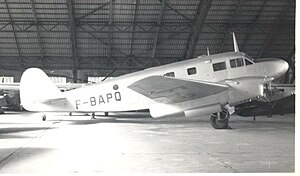Caudron C.440 Goéland
| C.440 Goéland | |
|---|---|

| |
| Caudron C.449 Goeland trainer of Air France at Pontoise-Cormeilles airfield near Paris in May 1957 | |
| Role | Civil utility aircraft |
| Manufacturer | Caudron |
| Designer | Marcel Riffard |
| First flight | 1934 |
| Number built | 1,702 |
The Caudron C.440 Goéland ("seagull") was a six-seat twin-engine utility aircraft developed in France in the mid-1930s.
Design and development
It was a conventionally configured low-wing cantilever monoplane with tailwheel undercarriage. The main undercarriage units retracted into the engine nacelles. Construction was wooden throughout, with wooden skinning everywhere but the forward and upper fuselage sections, which were skinned in metal. As usually configured, the cabin seated six passengers with baggage compartments fore and aft, and a toilet aft.
Operation history
Apart from private buyers, the C.440 was also bought by the Armée de l'Air, Aéronavale, Aéromaritime, Règie Air Afrique and Air France, and some were exported for service with Aeroput. Production of the C.440 and its subtypes continued until the outbreak of World War II, at which time many C.440s were impressed into military service. Following the fall of France, some were operated by the German Luftwaffe and Deutsche Luft Hansa. Another user was the Slovenské vzdušné zbrane - it ordered 12 aircraft as the C.445M in 1942.
Production was restarted following the war for both military and civil use as a transport and as a twin-engined trainer. In the post war reorganisation of the French aircraft industry, Caudron became part of SNCA du Nord, and the aircraft became the Nord Goeland; 325 of these were built.[1] Post-war commercial operators included Air France, SABENA, Aigle Azur, and Compagnie Air Transport (CAT).
Variants
- C.440 - prototype (3 built)
- C.441 - version with Renault 6Q-01 engine and dihedral added to outer wing panel (4 built)
- C.444 - first version with counter-rotating propellers, adopted on all later versions (17 built)
- C.445 - similar to C.444, but dihedral of outer wing panels increased (114 built)
- C.445/1 - 2 built
- C.445/2 - 3 built
- C.445/3 - postwar production version (510 built)
- C.445M - militarised version (404 built)
- C.445R - long-range version (1 built)
- C.446 Super Goéland - 1 built
- C.447 - air ambulance version (31 built)
- C.448 - version with supercharged engines (7 built)
- C.449 - final production version (349 built, including subtypes below)
- C.449/1
- C.449/2
- C.449/3
- C.449/4 - photographic survey version
- C.449/5
Operators
- Air Bleu
- Aéromaritime[2]
- Aeronavale
- Aigle Azur
- Air France
- Armee de l'Air
- Compagnie Air Transport (CAT)
- Règie Air Afrique[2]
- Aeroput
- Yugoslav Royal Air Force - One aircraft was impressed into military in April 1940.
Specifications (C.445M)

General characteristics
- Crew: Two pilots
Performance
See also
Related lists
References
Citations
- ^ Green 1954, p. 88
- ^ a b Air-Britain Aviation World December 2011 p.173
Bibliography
- Taylor, Michael J. H. (1989). Jane's Encyclopedia of Aviation. London: Studio Editions. p. 240.
- World Aircraft Information Files. London: Bright Star Publishing. pp. File 891 Sheet 15.
- Green, William (1954). The World's Fighting Planes (edition ed.). London: McDonald.
{{cite book}}:|edition=has extra text (help); Unknown parameter|coauthors=ignored (|author=suggested) (help)
